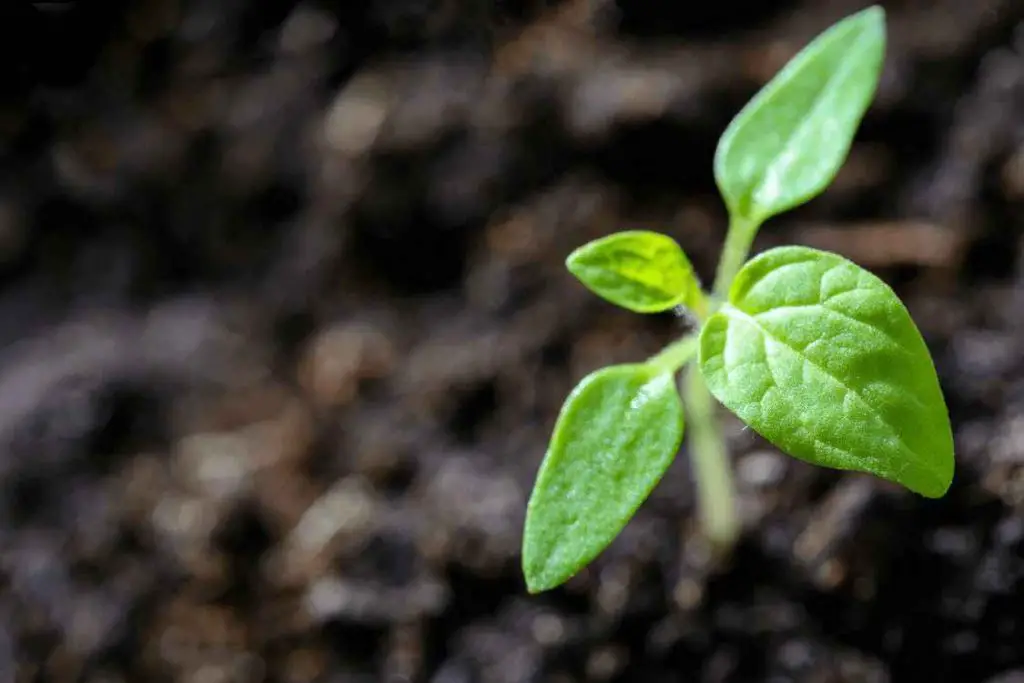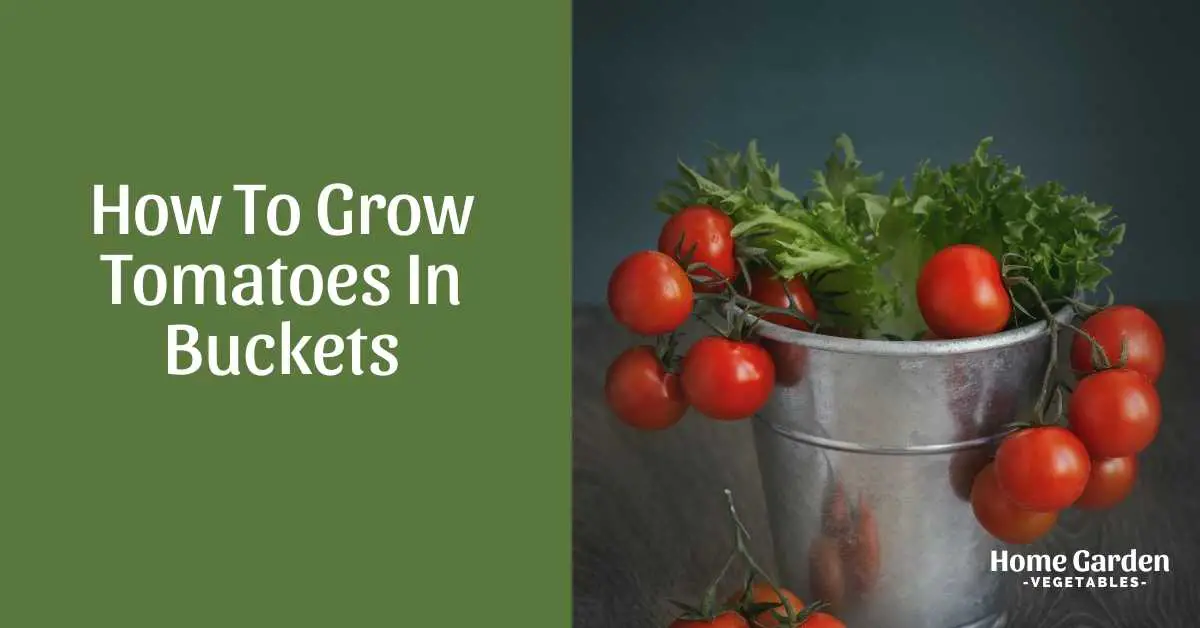Gardeners have been growing tomatoes in containers for a long time. But what about buckets? Can tomatoes grow in buckets? After all, they’re cheap, lightweight and can come in big sizes – all the right reasons to get planting in them! How to grow tomatoes in buckets and are there any special tips to make the harvest plentiful and flavorful?
Keep reading and you’ll learn all about growing tomatoes in a bucket.
Reader Poll: What online courses would interest you?

Why Grow Tomatoes In Buckets

So are there any tangible benefits of growing tomatoes in buckets over backyard gardening? And are buckets a preferable choice over the regular pots? Here are the major benefits you can expect when growing tomatoes in buckets:
- You don’t have a huge backyard to grow food for the family? No worries. That’s what buckets are for – your personal little garden wherever you want it to be!
- Growing tomatoes in buckets saves you from plenty of nuisance associated with backyard gardening. Aphids, cutworms and hornworms will be much less likely to attack your bucket tomato plants.
- Don’t forget the soil! While you can perfect your plants’ nutrient supply with the best organic potting soil in a bucket, it’s not too easy to do so when growing in the garden. Soil-borne diseases are also less common in bucket growing tomatoes.
- Buckets are cheap! You can get multiple 5-gallon buckets at minimal prices to build a reasonably sized garden to cater to the family’s requirements.
- They’re lightweight and portable. If your tomatoes aren’t getting enough sun at a spot you chose initially, simply lift the bucket and carry it to a suitable spot. In contrast, imagine digging up a tomato garden and replanting it elsewhere! It’s a risky job; some plants might not even survive the transfer.
What Size Bucket Do You Need?

Make sure that the bucket you choose is big enough to carry the plant’s roots. Rootbound tomato plants won’t produce a great harvest. A 12-inch depth is ideal for most tomato varieties. The usual 5-gallon buckets work best for them. They are just the right diameter and depth for growing a single tomato plant.
How Many Tomato Plants Per Bucket?
Crowding too many tomatoes in a single bucket isn’t a wise choice. It will leave them competing for sunlight, space and nutrients, resulting in diminished growth of all plants. Adequate spacing is important if you want to see each plant growing healthy and producing lots of juicy tomatoes. If you have a 5-gallon bucket, cherry or bush tomatoes are the better choice. Sow two to three seeds in the bucket, but thin to a single, healthiest seedling once they’re a few inches tall.
Subscribe to our newsletter!
In short, grow a single cherry tomato plant per 5-gallon bucket.
If you want to grow a large variety, a single plant should be planted in a 10-gallon bucket. If you’re growing cherry tomatoes, you can grow two plants in the same size.
Prepare Bucket For Growing Tomatoes

Drainage Holes
Make sure the bucket has drainage holes at the base. If it didn’t come with drainage holes you can drill some. These holes will let out the excess water so your plants won’t have wet feet. A small hole every 3 inches is sufficient to keep your tomato plants comfortable after each watering. Add some gravel to the base before putting in the soil. This will further help with the drainage.
Soil
Use a good quality potting mix to fill the container. It’s also a good idea to add in some additional organic material to help perfect the soil texture and maintain an adequate nutrient supply. For example, you can add equal amounts of potting soil, perlite, peat moss and compost to create your own special mix.
How Much Soil To Grow Tomatoes In Buckets?
Once you’ve prepared the soil, it’s time to add it to the bucket. Fill it up half to three-quarters of its original capacity using the mix you created.
Planting Tomatoes In Buckets

If you’re growing from seedlings bought from a nursery, here’s what you do:
- Remove the seedlings from the original pot. Be careful not to damage the roots.
- Place it at the center of the bucket.
- Backfill with more prepared soil, covering the roots and the stem. Only the top 2 to 4 leaves should be exposed above the soil.
- Water slowly and deeply until it appears from the drainage holes.
If you’re sowing seeds, plant 2 to 3 seeds, a few inches apart in the bucket filled 3/4th with potting mix. Cover it lightly with an inch of soil.
Supporting Tomatoes In Buckets
Indeterminate tomatoes always need support. Most determinate varieties also do better with some support. It’s best to add a trellis, tomato cage, or stake to the bucket right after you plant the seedling. You might risk damaging the plant’s roots if you add the support later.
Is The Yield Higher In Buckets?

Your tomato plants won’t know whether they’re growing in pots, buckets or ground. They only care about their requirements. As long as you give them what they need, they’ll repay with a bumper crop. You can have a high yield in buckets if you choose the correct size, use good quality soil and give your plants plenty of sunlight, along with adequate water and fertilizers.
Caring For Tomato Plants In A Bucket
Container grown plants, tomatoes and others, often require more frequent care than in-ground plantings. When they drain the water and nutrients from the soil, there isn’t much surrounding soil to replenish it.
- Watering Requirements
Soil in containers dries out quicker than it does in the ground. Water the tomato plants at a suitable frequency such that the soil always stays moist below the surface. Fruit splitting is a common problem in tomatoes and it results from inconsistent watering. Water deeply each time the soil feels dry an inch below the surface.
Water slowly and deeply until it runs out through the drainage holes at the bottom of the bucket. You may have to water twice a day if the weather is really hot and dry. Check the moisture in the morning, and once again in the evening to see if the soil is dry below 1 inch from the surface. If it’s dry, offer the plants another drink. Add some light mulch to conserve moisture.
Too much water isn’t good for tomatoes either. Keep the soil moist, but not wet. Excessive moisture can cause the plants to drown and result in root rot.
- Sunlight
Tomatoes are sun-loving plants. They grow best when they get lots of bright sunshine and warm temperatures. At least 6 hours of full sun is a requirement, but more is even better.
The good thing about buckets is that you don’t have to make a decision on where to plant them right from the start. Even if the location you chose initially doesn’t get enough sunlight, you can easily relocate it to a brighter spot.
- Fertilizer Requirements
Tomatoes growing in buckets need to be fed regularly. While in-ground tomato plants can get their nutrients from the surrounding soil, bucket-grown tomatoes rely on fertilizers for their requirements.
Mix slow-release, granular organic fertilizer into the potting soil at the time of planting if the potting soil does not include fertilizer in its composition. Supplement it with a dose of liquid organic fertilizer every 2 to 3 weeks for a consistent supply of nutrients.
Additionally, you can add a little Epsom salt to the potting soil to prevent magnesium deficiency and reduce the likelihood of blossom end rot.
- Keep Of Pests
Tomatoes often attract pests and insects. Make sure pests can’t get to your plants and damage the crop. After planting, you can enclose the plants in a cylindrical cage reinforced with nylon netting. The cage will serve the dual purpose of giving the plants support and warding off pests.
If the plants get an infestation, it can be countered with a spray of insecticidal soap. Heavy infestations can be treated with commercially available chemical insecticides. However, make sure that the insecticides are labeled for use in the vegetable garden.

